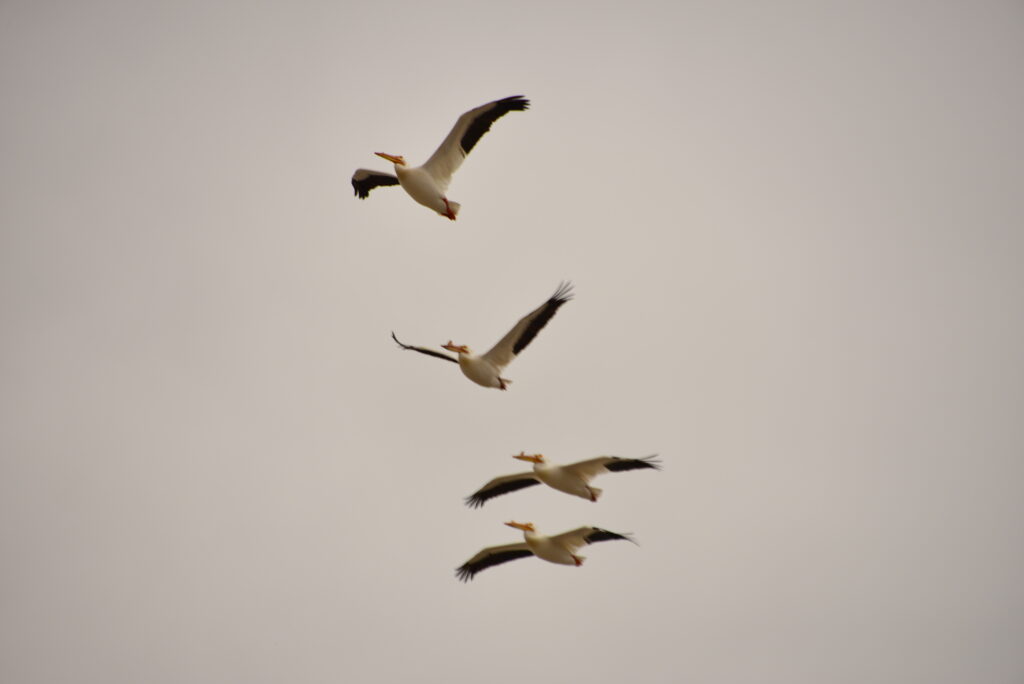
There are plenty of birds in Florida to see while you’re out and about.
©iStock.com/Elizabeth Lara
Florida is full of all sorts of diverse wildlife, including birds. Most of the larger birds you’ll see in the state are waterfowl and similar species, but not all. If you’ve ever wondered what the largest flying birds in Florida are, and where they live, this list of the 27 largest flying birds (by wingspan) is sure to impress!
1. American White Pelican (Pelecanus erythrorhynchos) — 114-Inch Wingspan
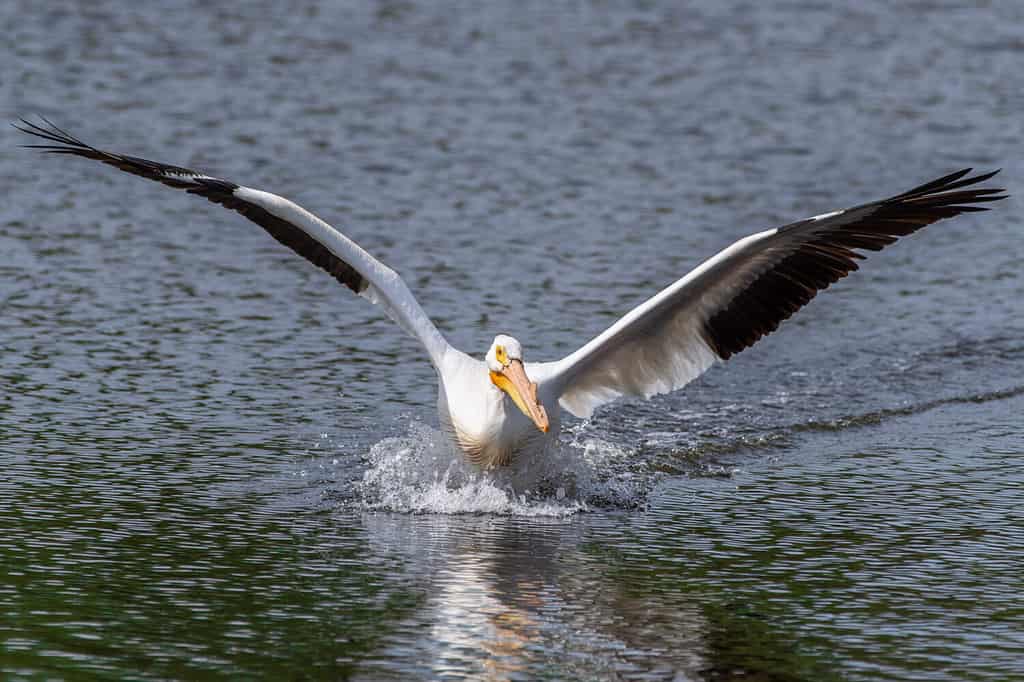
The American white pelican is certainly a sight to see on the water.
©Mike Lynds/Shutterstock.com
The American white pelican is quite a large bird and is the largest flying bird in Florida. From wingtip to wingtip it reaches out to over 100 inches. They enjoy spending time in and near the water.
- Wingspan: 96-114 inches (244-290 cm)
- Length: 50-65 inches (127-165 cm)
- Weight: 158-317 ounces (4500-9000 g)
- Lifespan: 16-30 years
- Florida Range: Enjoys all of Florida in the winter months
2. Whooping Crane (Grus americana) — 90-Inch Wingspan

Whooping cranes aren’t the largest bird in Florida, but they are close.
©Kent Ellington/Shutterstock.com
The whooping crane is an amazing story of survival. Back in the 1940s, there were only 20 of the species left. Thanks to various captive breeding and wetland management initiatives, the number is over 600 today.
- Wingspan: 90 inches (229 cm)
- Length: 59 inches (150 cm)
- Weight: 211-275 ounces (6000-7800 g)
- Lifespan: 22-40 years
- Florida Range: Central and northern Florida
3. Magnificent Frigatebird (Fregata magnificens) — 88-Inch Wingspan
The magnificent frigatebird isn’t a bird you’ll find lounging around. They enjoy soaring right along the coast. Walk alongside almost any beach in Florida and you’re sure to see them at certain times of the year.
- Wingspan: 85-88 inches (217-224 cm)
- Length: 35-45 inches (89-114 cm)
- Weight: 35-67 ounces (1000-1900 g)
- Lifespan: Up to 34 years
- Florida Range: The tip of Florida and around the coasts
4. Golden Eagle (Aquila chrysaetos) — 86-Inch Wingspan
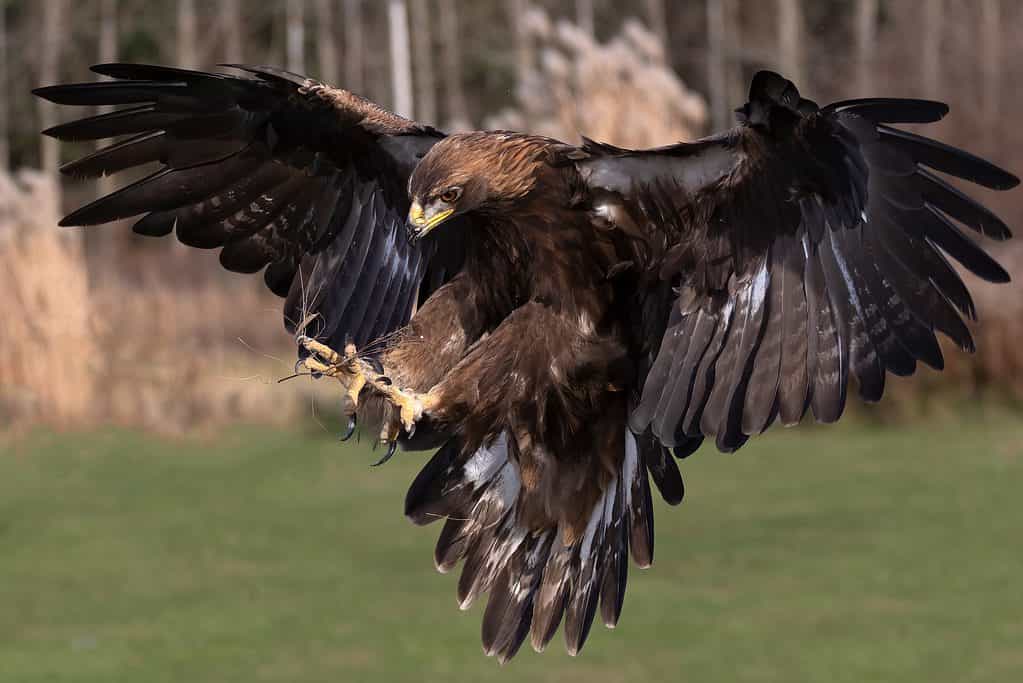
Golden eagles are national birds of many countries.
©Touched by light images/Shutterstock.com
The golden eagle is a very majestic bird. They are considered to be one of the fastest, largest, and nimblest raptors in all of North America.
- Wingspan: 72-86 inches (185-220 cm)
- Length: 27-33 inches (70-84 cm)
- Weight: 105-216 ounces (3000-6125 g)
- Lifespan: 30 years or more
- Florida Range: The panhandle during non-breeding season
5. Bald Eagle (Haliaeetus leptocephalus) — 80-Inch Wingspan

Bald eagles are related to gulls.
©PHOTOOBJECT/Shutterstock.com
Pretty much anyone in the US has seen a bald eagle. They’re the bird that best represents the US. They have also had a long history as a spiritual creature for many people living on the land.
- Wingspan: 80 inches (204 cm)
- Length: 28-37 inches (71-96 cm)
- Weight: 105-222 ounces (3000-6300 g)
- Lifespan: 15-25 years
- Florida Range: Found year-round in all parts of Florida
6. Great Blue Heron (Ardea herodias) — 79-Inch Wingspan
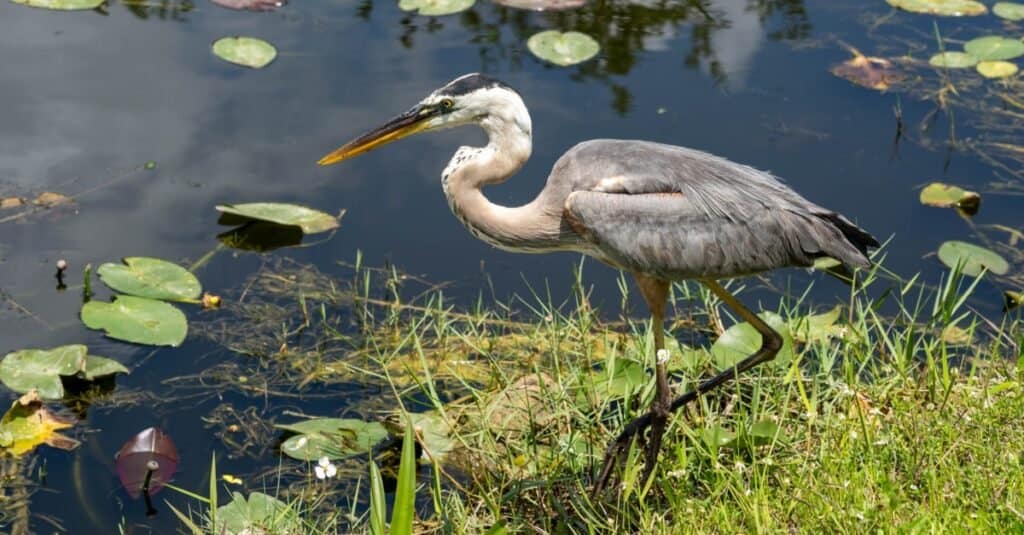
A great blue heron fishing in the Florida Everglades is a sight any Floridian knows well.
©ttomasek15/Shutterstock.com
Great blue herons are beautiful and elegant birds with a blue hue, as the name suggests. However, there is a white variation of this species, known as a great white heron, which can be found in Southern Florida.
- Wingspan: 65-79 inches (167-201 cm)
- Length: 38-54 inches (97-137 cm)
- Weight: 71-88 ounces (2100-2500 g)
- Lifespan: 15-23 years
- Florida Range: All of Florida, year-round
7. Trumpeter Swan (Cygnus buccinator) — 79-Inch Wingspan
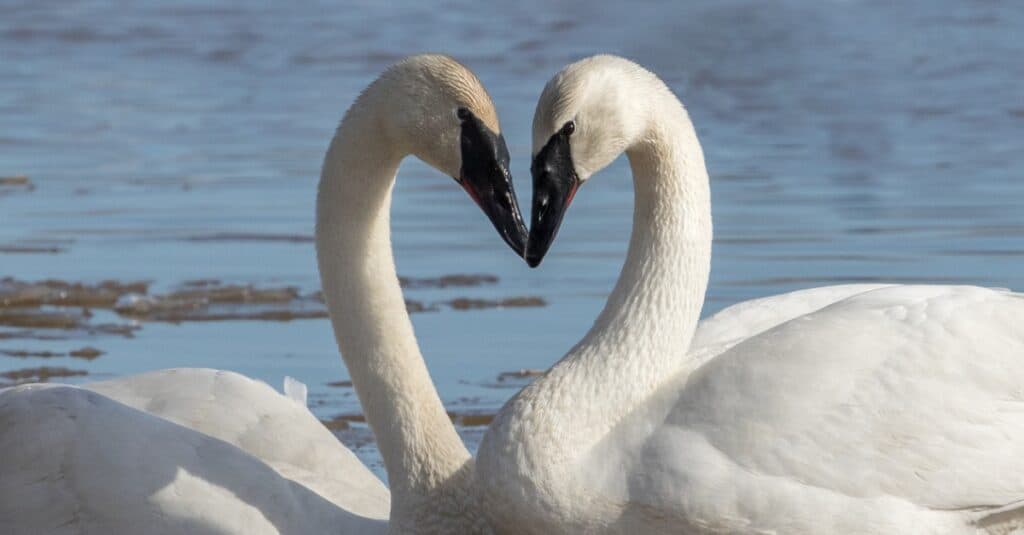
Trumpeter swans pick mates when they’re still too young to breed.
©iStock.com/Dee Carpenter Photography
The trumpeter swan isn’t much of a Florida resident. They visit the panhandle of Florida occasionally in the winter and are quite hard to find.
- Wingspan: 79 inches (203 cm)
- Length: 54-62 inches (138-158 cm)
- Weight: 271-448 ounces (7700-12700 g)
- Lifespan: Up to 25 years old
- Florida Range: Sometimes found in one spot near the panhandle during winter
8. Brown Pelican (Pelecanus occidentalis) — 78-Inch Wingspan
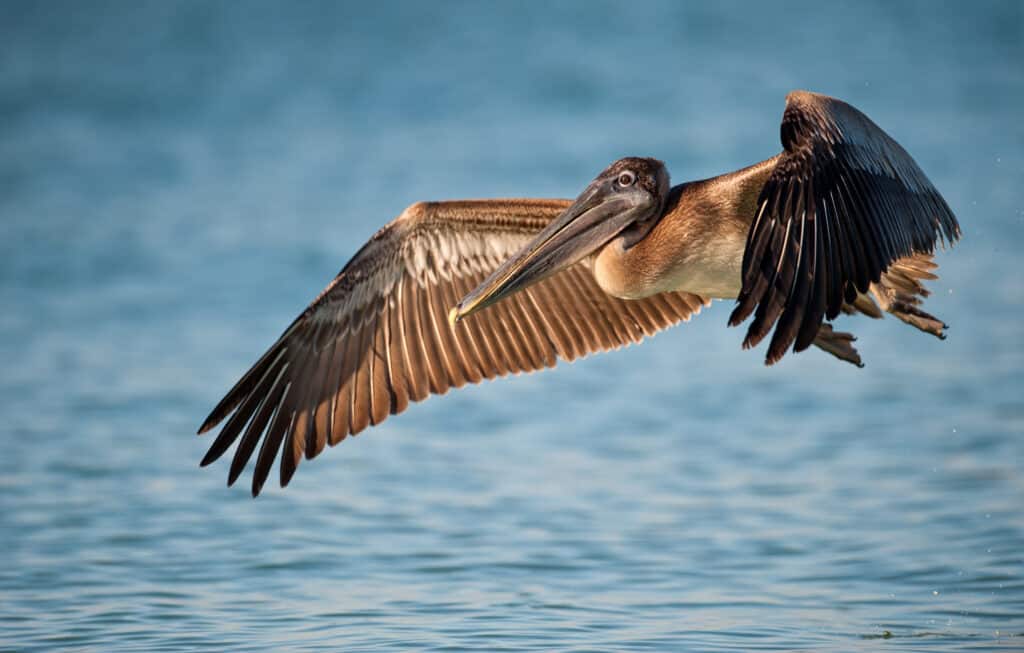
Even though they only rank 8th on the list, brown pelicans have a wide wingspan.
©Nagel Photography/Shutterstock.com
Brown pelicans were once in a lot of danger from pesticide pollution, but have managed to make a full recovery. Now, they’re listed as low concern on the IUCN conservation list.
- Wingspan: 78 inches (200 cm)
- Length: 39-54 inches (100-137 cm)
- Weight: 70-176 ounces (2000-5000 g)
- Lifespan: Over 20 years
- Florida Range: Found year-round along the coasts of Florida
9. Sandhill Cranes (Antigone canadensis) — 78-Inch Wingspan
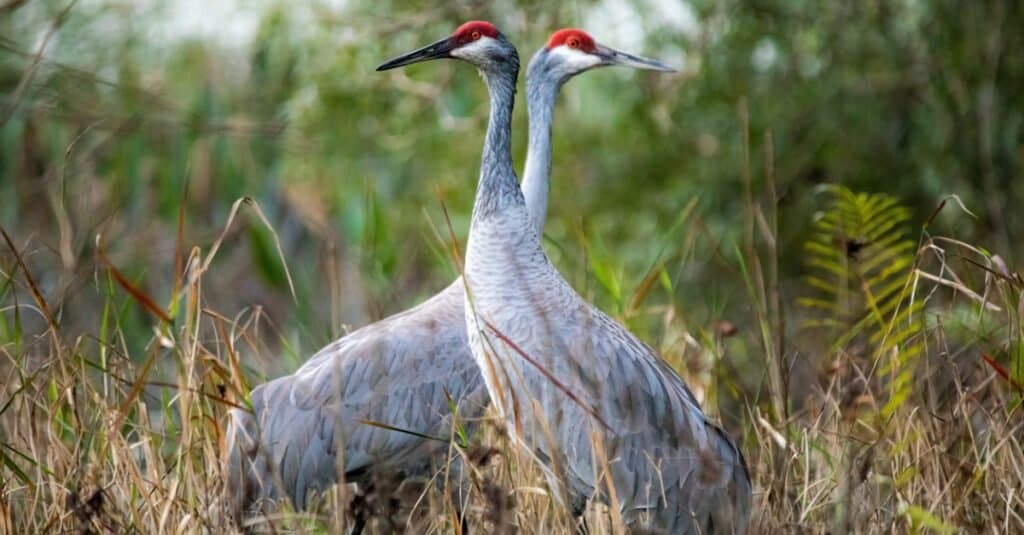
One can often find sandhill cranes wandering through people’s yards in Florida.
©iStock.com/GummyBone
Sandhill cranes have an interesting life. They enjoy dancing in their free time and to show off. They’ve also inspired people all over the world, including Aldo Leopold due to their noble nature. They may not be the largest bird in Florida, but they’re still an impressive sight.
- Wingspan: 78 inches (200 cm)
- Length: 47 inches (120 cm)
- Weight: 120-172 ounces (3400-4900 g)
- Lifespan: 20-30 years
- Florida Range: All of Florida except the panhandle
10. Osprey (Pandion haliaetus) — 71-Inch Wingspan

These osprey are accurate and elegant hunters.
©Wang LiQiang/Shutterstock.com
Osprey have long migrations. In 20 years, osprey may travel over 160,000 miles just to migrate. One osprey was found to travel over 2,700 miles in 13 days.
- Wingspan: 59-71 inches (150-180 cm)
- Length: 21-22 inches ( 54-58 cm)
- Weight: 49-70 ounces (1400-2000 g)
- Lifespan: 15-20 years
- Florida Range: Almost all of Florida
11. Northern Gannet (Morus bassanus) — 71-Inch Wingspan
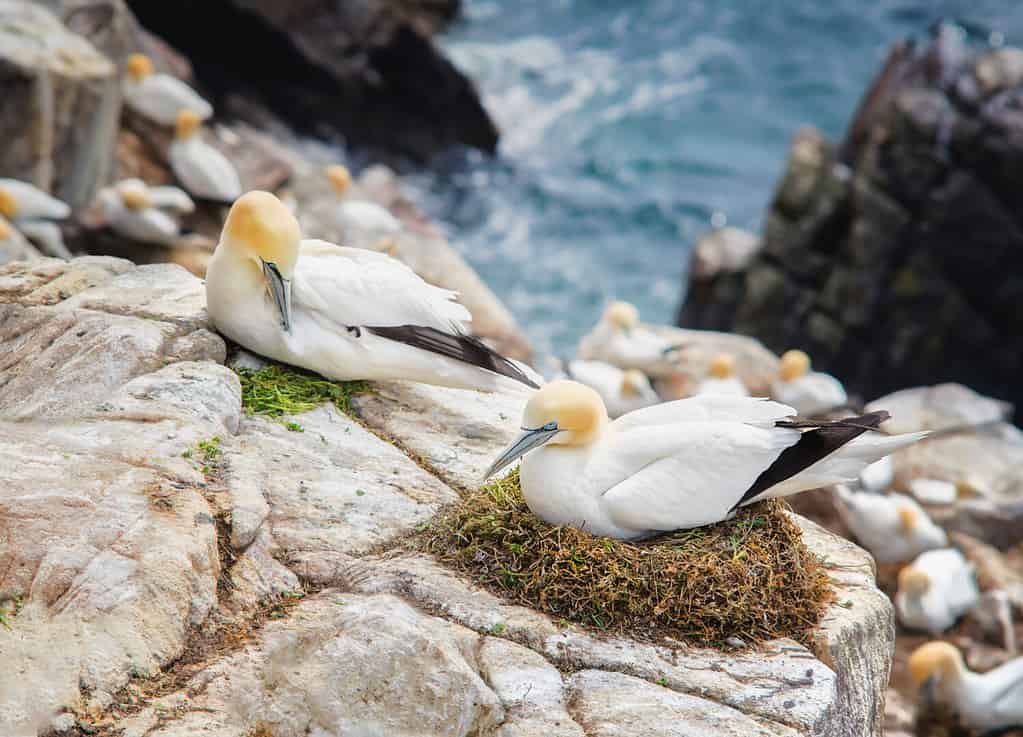
The northern gannet has excellent vision.
©Algirdas Gelazius/Shutterstock.com
Gannets are almost the same size as an albatross. They have amazing vision to catch prey. They can even see underwater thanks to unique adaptations.
- Wingspan: 71 inches (180 cm)
- Length: 36-43 inches (92-110 cm)
- Weight: 87-127 ounces (2470-3610 g)
- Lifespan: 17-37 years old
- Florida Range: All along the coast of Florida
12. Turkey Vulture (Cathartes aura) — 70-Inch Wingspan
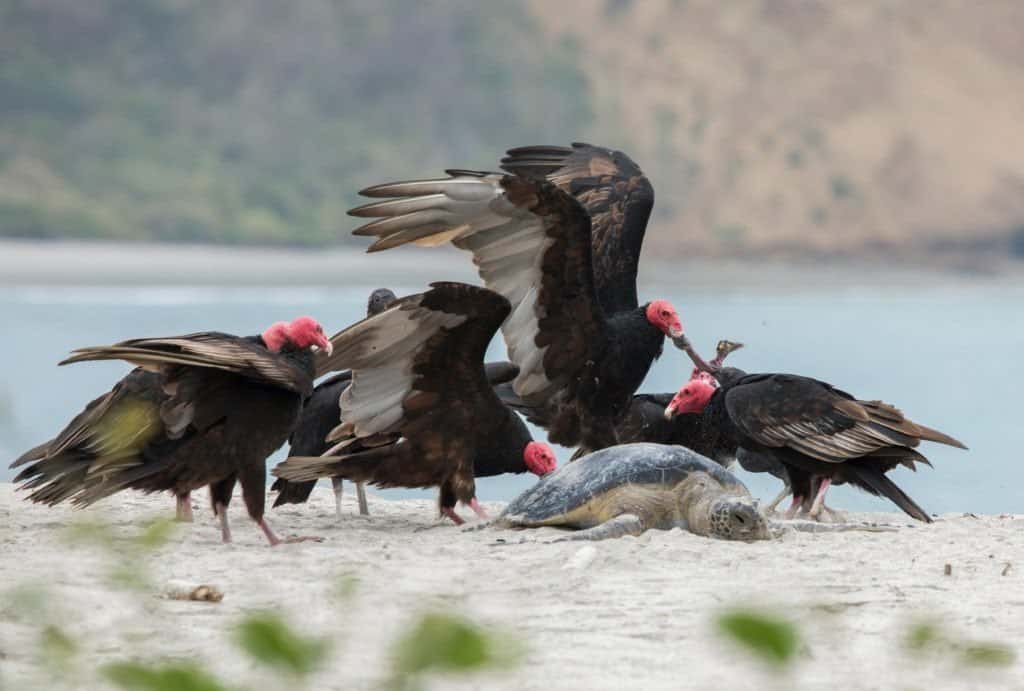
Thanks to their bright red heads, turkey vultures are easily recognizable.
©Ana Dracaena/Shutterstock.com
Turkey vultures look a lot like vultures seen in areas like Asia, Europe, and Africa. Despite their similar appearance, they are pretty distinct. They’re not even in the same taxonomic orders. Their features are likely similar due to convergent evolution.
- Wingspan: 67-70 inches (170-178 cm)
- Length: 24-32 inches (64-81 cm)
- Weight: 70 ounces (2000 g)
- Lifespan: Up to 16 years
- Florida Range: Year-round throughout all of Florida
13. Wood Stork (Mycteria americana) — 69-Inch Wingspan

Wood storks are huge birds with an impressive wingspan.
©Breck P Kent/Shutterstock.com
The wood stork stands a little over three feet tall, most of which comes from its legs. Of course, its long legs allow it to walk through its favorite habitat, the wetlands. If this was a list of the largest birds in Florida by length, this one would probably be well at the top.
- Wingspan: 59-69 inches (150-175 cm)
- Length: 33-45 inches (85-115 cm)
- Weight: 72-93 ounces (2050-2640 g)
- Lifespan: Up to 22 years
- Florida Range: All of Florida at various times of the year
14. Canada Goose (Branta canadensis) — 67-Inch Wingspan
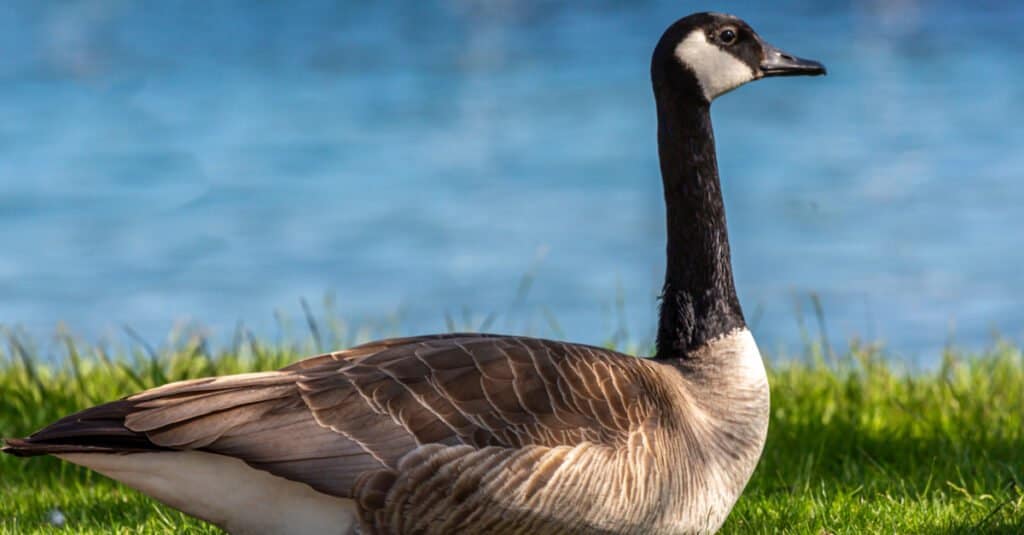
The Canada goose eats the blade, stem, and roots of the grass.
©David McIntosh/Shutterstock.com
There’s a lot to learn about Canadian geese. For one, over 11 subspecies of this goose have been recognized, even though most subspecies look like each other. Generally, though, the species grows smaller as you go north and darker as you go west.
- Wingspan: 50-67 inches (127-170 cm)
- Length: 30-43 inches (76-110 cm)
- Weight: 105-317 ounces (3000-9000 g)
- Lifespan: 10-24 years
- Florida Range: North-Central Florida
15. Great Black-Backed Gull (Larus Marinus) — 63-Inch Wingspan
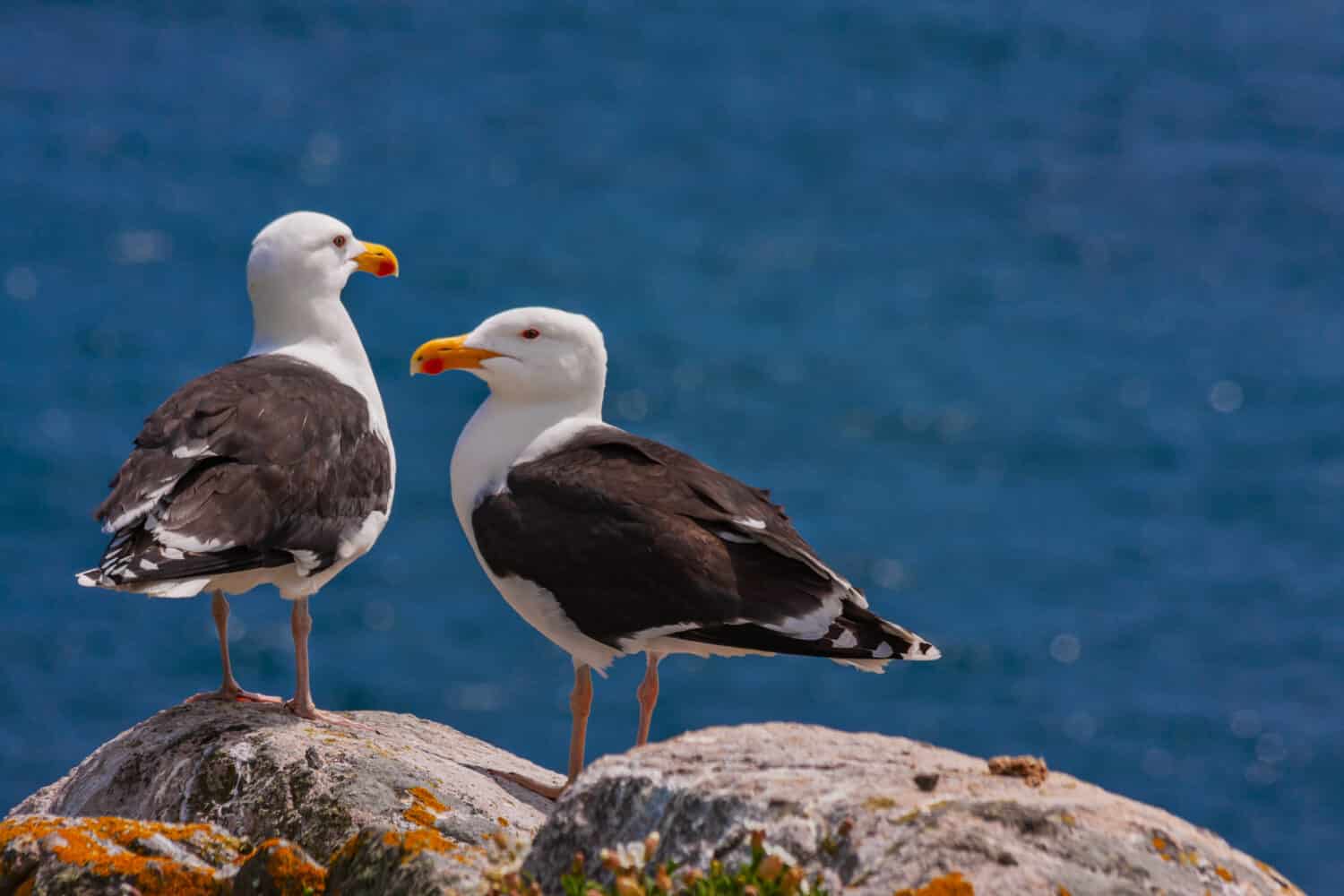
These gulls are a bit larger than other gulls you might come across.
©Nicola_K_photos/Shutterstock.com
The great black-backed gull is considered to be the largest gull in the world. They pick on other birds, bothering them so they can steal all of their food. While most gulls are rather small, this one makes it on the list of the largest flying birds in Florida.
- Wingspan: 57-63 inches (146-160 cm)
- Length: 28-31 inches (71-79 cm)
- Weight: 46-70 ounces (1300-2000 g)
- Lifespan: 10-25 years
- Florida Range: Along the North-Eastern coast of Florida
16. Masked Booby (Sula Dactylatra) — 63-Inch Wingspan
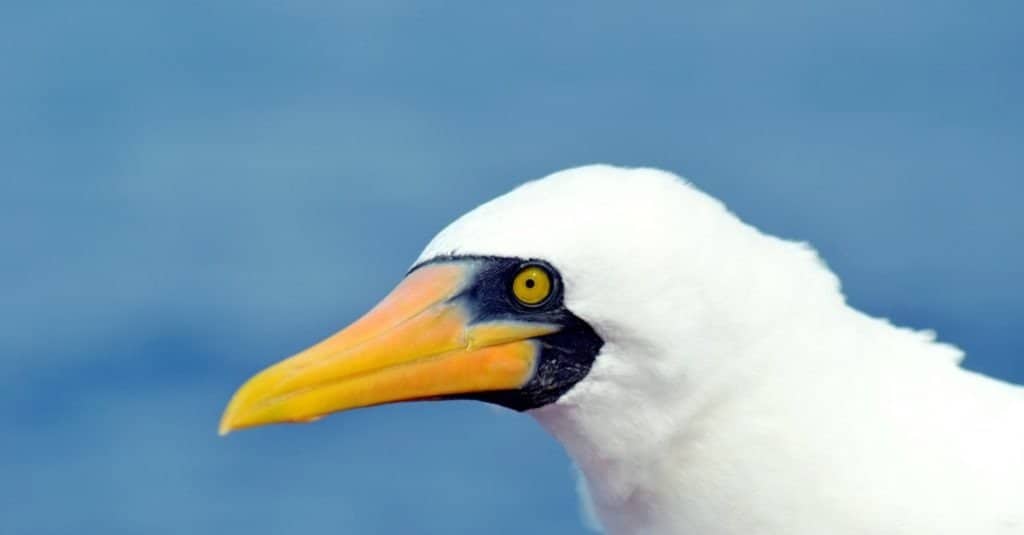
A masked booby may dance silly, but they’re still great hunters.
©Mariusz Bugno/Shutterstock.com
The masked booby looks a lot like a gannet, but they have a black mask around their beak and thicker black tips on their feathers. Interestingly enough, the name “booby” is derived from the Spanish word bobo, which means “fool”. This comes from their unique and silly courtship dances.
- Wingspan: 63 inches (160 cm)
- Length: 29-34 inches (74-86 cm)
- Weight: 46-83 ounces (1300-2350 g)
- Lifespan: Up to 25 years
- Florida Range: Over the water on the tip of South Florida
17. Black Vulture (Coragyps atratus) — 59-Inch Wingspan
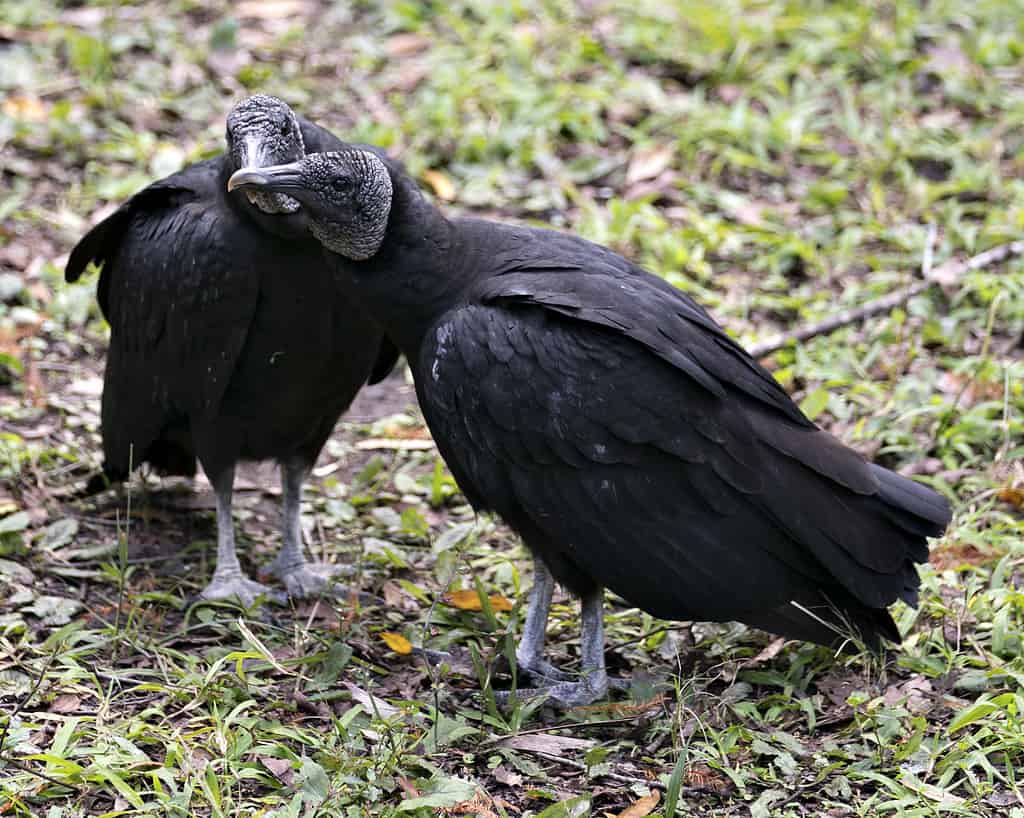
Black vultures rely on turkey vultures for hunting.
©iStock.com/Rejean Bedard
Turkey vultures technically outnumber black vultures in the US. However, thanks to their wide range, black vultures are the most common vultures in the Western Hemisphere. Unfortunately, black vultures are also not as good at smelling prey as turkey vultures
- Wingspan: 53-59 inches (137-150 cm)
- Length: 23-26 inches (60-68 cm)
- Weight: 56-77 ounces (1600-2200 g)
- Lifespan: Around 20 years
- Florida Range: All of Florida year-round
18. Herring Gull (Larus argentatus) — 57-Inch Wingspan
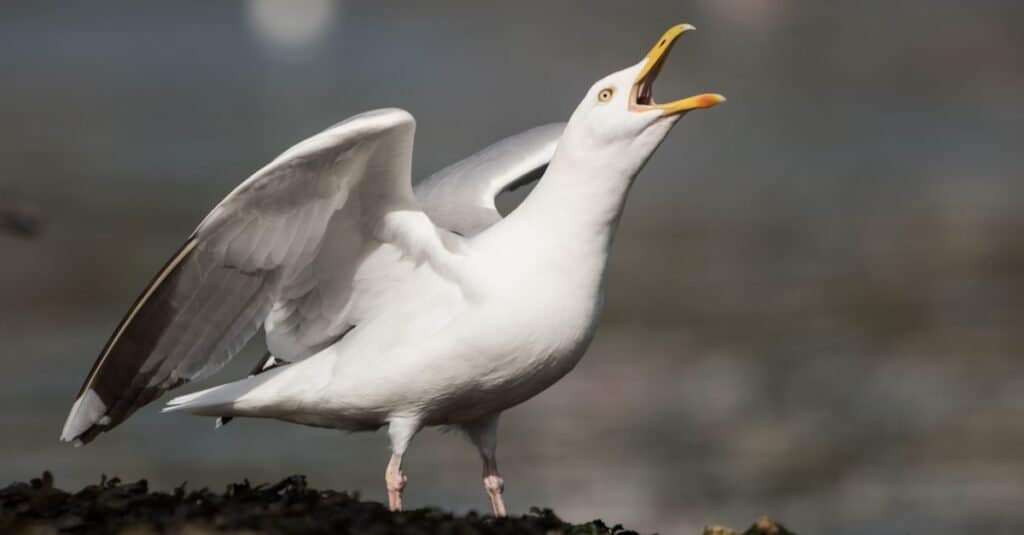
The boldness of the herring gull, together with its sharp beak, makes them potentially very dangerous.
©Maciej Olszewski/Shutterstock.com
Herring gulls are a bird with a wide range. Though they are most commonly thought of as sea birds, they visit most of central Canada and the US. Additionally, their range is spreading, even displacing the laughing gull from some areas. This may be due to their large size which has them listed as one of the largest birds in Florida.
- Wingspan: 54-57 inches (137-146 cm)
- Length: 22-26 inches (56-66 cm)
- Weight: 28-44 ounces (800-1250 g)
- Lifespan: 40-50 years
- Florida Range: All of Florida for winter
19. Great Horned Owl (Bubo virginianus) — 57-Inch Wingspan
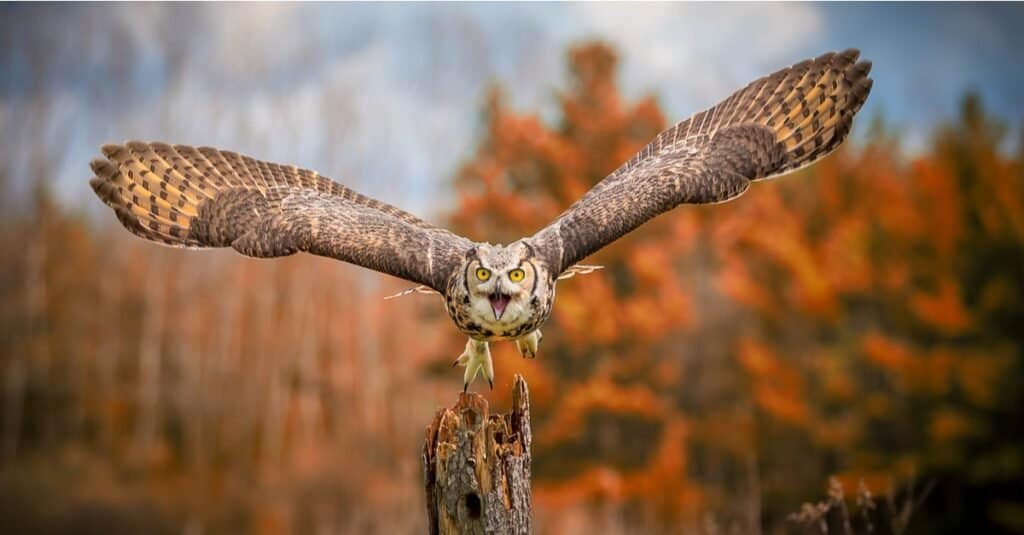
A great horned owl will fight almost anything.
©Imran Ashraf/Shutterstock.com
The great horned owl is a fierce predator. They will take on birds larger than them, like ospreys. They’ll also fight and eat other owls and falcons. However, a great-horned owl is happier with smaller prey as well, including mice, frogs, and scorpions.
- Wingspan: 39-57 inches (101-145 cm)
- Length: 18-24 inches (46-63 cm)
- Weight: 32-88 ounces (910-2500 g)
- Lifespan: 20-30 years
- Florida Range: All of Florida year-round
20. Great Egret (Ardea alba) — 57-Inch Wingspan
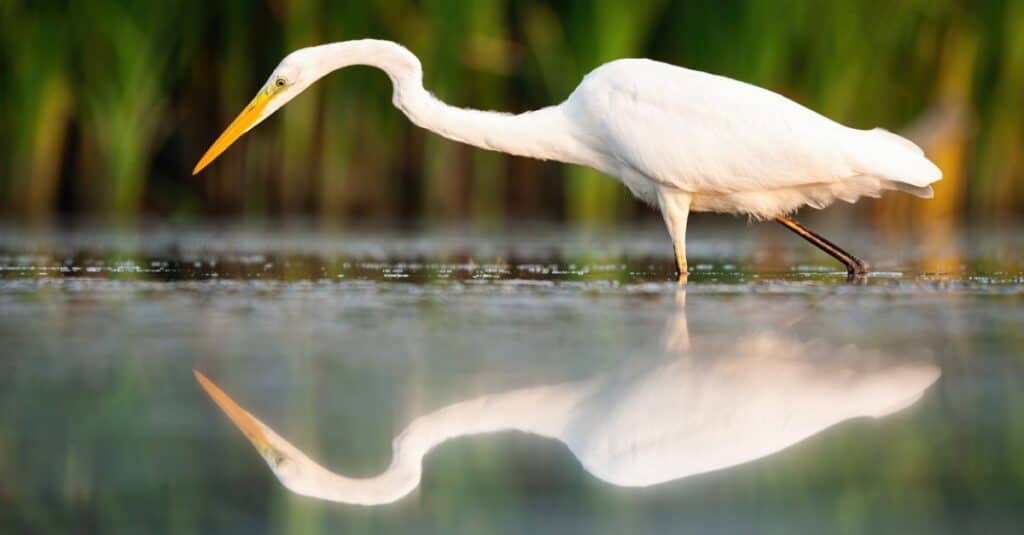
The great egret is elegant, but a little slow.
©WildMedia/Shutterstock.com
Great egrets are a little smaller than a great blue heron but are still quite large birds to find in the wetlands. Moreover, these animals are so enchanting that they became the symbol of the National Audubon Society.
- Wingspan: 51-57 inches (131-145 cm)
- Length: 37-41 inches (94-104 cm)
- Weight: 35 ounces (1000 g)
- Lifespan: Around 15 years
- Florida Range: All of Florida year-round
21. Wild Turkey (Meleagris gallopavo) — 56-Inch Wingspan
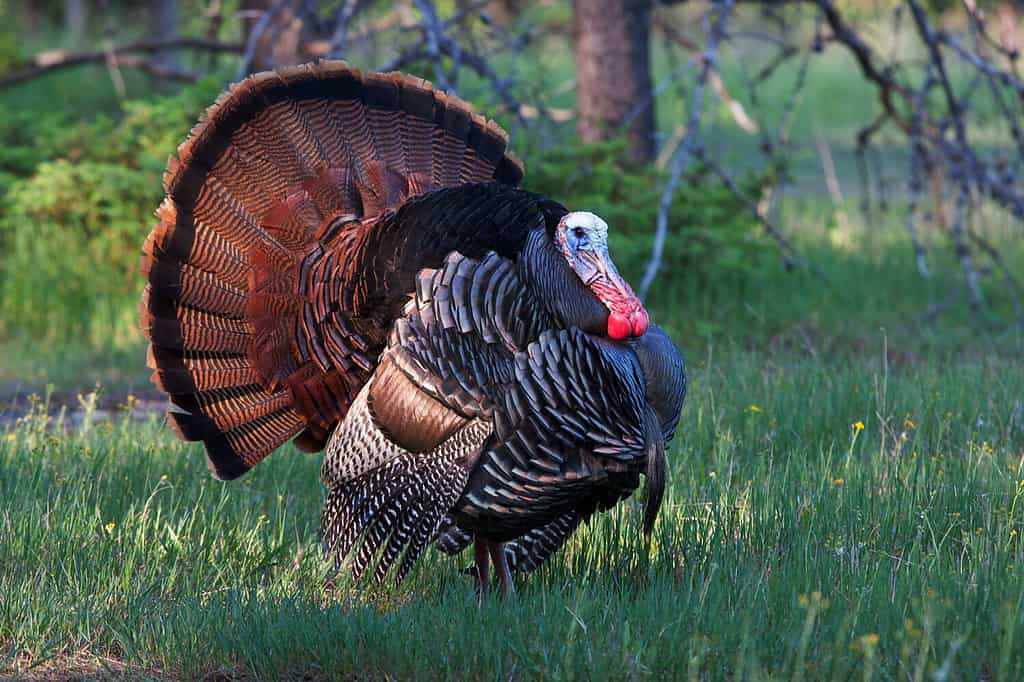
Wild turkeys are a common bird to see in the woods strutting around.
©Jim Cumming/Shutterstock.com
Also known as the eastern turkey, the wild turkey is only one of two domesticated birds native to the Americas. The other is the Muscovy duck. Interestingly, they weren’t domesticated in the US. They were found in Mexico by Europeans and domesticated there before being brought back to the US.
- Wingspan: 49-56 inches (125-144 cm)
- Length: 43-45 inches (110-115 cm)
- Weight: 88-381 ounces (2500-10800 g)
- Lifespan: 3-5 years
- Florida Range: All of Florida year-round
22. Red-Tailed Hawk (Buteo jamaicensis) — 52-Inch Wingspan
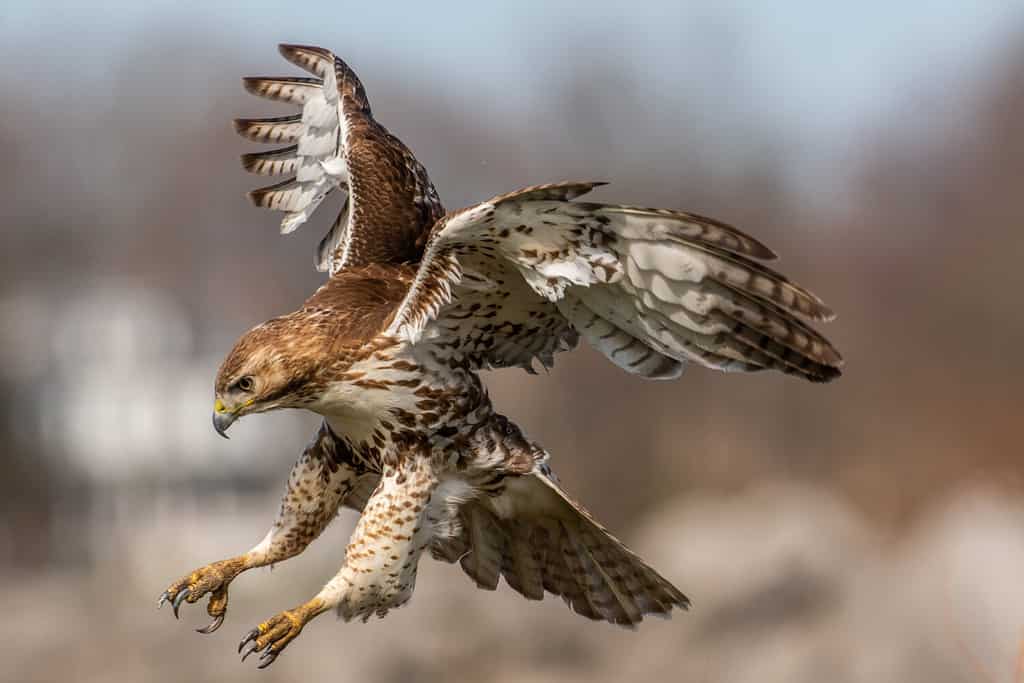
This is the bird responsible for every “eagle” cry in movies.
©David Brace/Shutterstock.com
The red-tailed hawk is the most common hawk in North America. One fun fact is that in movies when you think you’re hearing a bald eagle, you’re hearing a red-tailed hawk. In addition, they’re also a rather big hawk, making them one of the largest birds in Florida.
- Wingspan: 45-52 inches (114-133 cm)
- Length: 17-25 inches (45-65 cm)
- Weight: 24-51 ounces (690-1460 g)
- Lifespan: Around 20 years
- Florida Range: All of Florida year-round
23. Common Loon (Gavia immer) — 51-Inch Wingspan

Common loons are full of unique patterns.
©Brian Lasenby/Shutterstock.com
The common loon only comes to the shore to nest. They prefer to spend their time in the water, catching prey, and swimming. They catch most of their food underwater and have serrated projections at the top of their mouth to keep hold.
- Wingspan: 41-51 inches (104-131 cm)
- Length: 26-35 inches (66-91 cm)
- Weight: 88-215 ounces (2500-6100 g)
- Lifespan: Around 25 years
- Florida Range: Migrate to all of Florida
24. Roseate Spoonbill (Platalea ajaja) — 51-Inch Wingspan
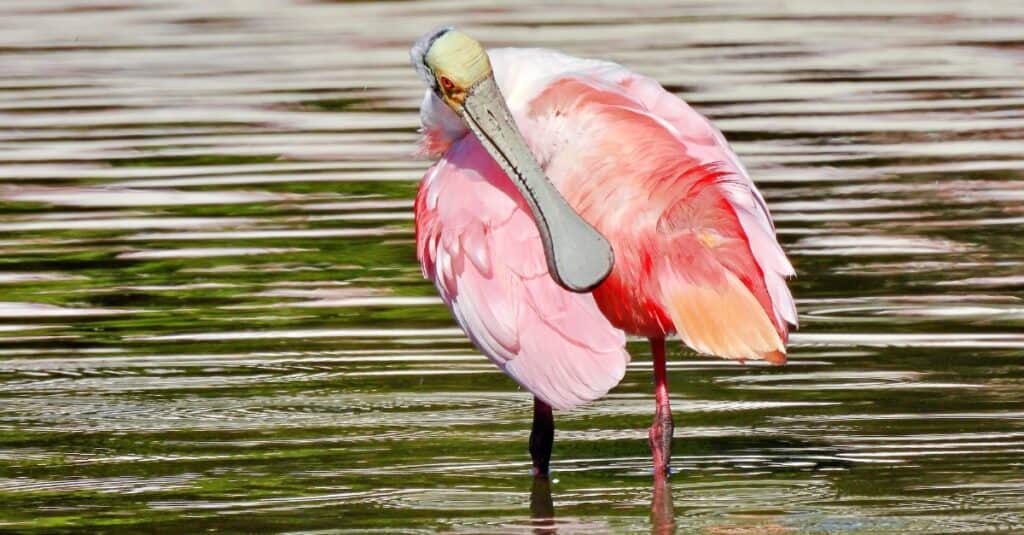
Roseate spoonbills look fake, but that’s their actual bill shape.
©iStock.com/passion4nature
The roseate spoonbill may look like a fake bird but is beautifully real. It’s the only spoonbill in the Americas. Besides the roseate spoonbill, there are five other spoonbill species and they are found in areas such as Europe, Australia, Asia, and Africa.
- Wingspan: 47-51 inches (120-130 cm)
- Length: 28-34 inches (71-86 cm)
- Weight: 88-215 ounces (2500-6100 g)
- Lifespan: 10-15 years
- Florida Range: Year-round in the southern tip of Florida
25. Caspian Tern (Hydroprogne caspia) — 50-Inch Wingspan
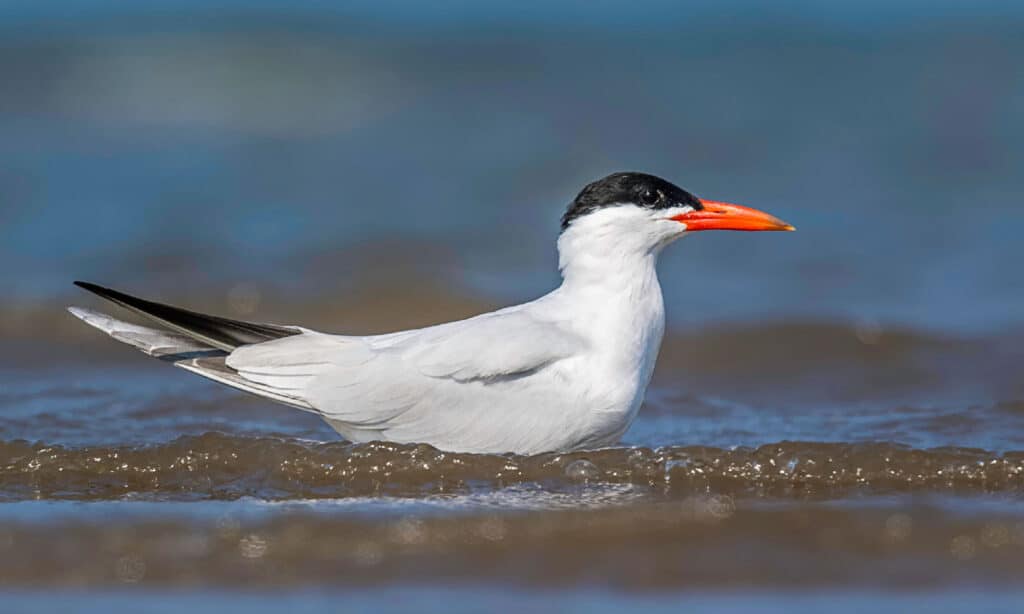
Caspian terns are aggressive birds around breeding season.
©Sriram Bird Photographer/Shutterstock.com
The Caspian tern earned its name by first being found in the Caspian Sea. It’s an aggressive bird that’s very protective of its breeding colony, even attacking people who get too close. Furthermore, the largest breeding colony is near Oregon and Washington and holds over 6,000 breeding pairs. That’s a lot of rather large birds in one area.
- Wingspan: 49-50 inches (126-128 cm)
- Length: 18-21 inches (47-54 cm)
- Weight: 18-27 ounces (530-782 g)
- Lifespan: Around 12 years
- Florida Range: All of Florida at various times of the year
26. Crested Caracara (Caracara plancus) — 49-Inch Wingspan

Also known as the Mexican eagle, these are rarely found in the US.
©iStock.com/Florence and Joseph McGinn
The crested caracara is very similar in appearance to a hawk, though it’s more of a falcon. This crested caracara is only found in a few select states in the US, preferring Mexico and South America for the majority of its range.
- Wingspan: 48-49 inches (122-125 cm)
- Length: 19-22 inches (49-58 cm)
- Weight: 37-46 ounces (1050-1300 g)
- Lifespan: Over 30 years
- Florida Range: Small South-Central part of Florida
27. Swallow-Tailed Kite (Elanoides forficatus) — 48-Inch Wingspan
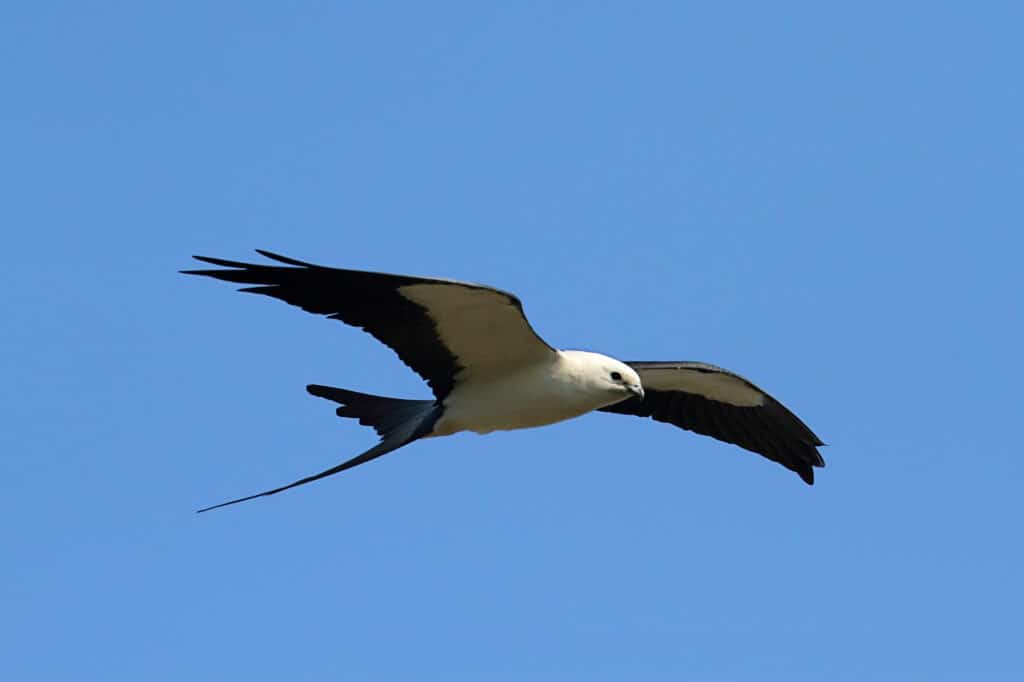
Swallow-tailed kites often eat while flying through the air.
©iStock.com/SteveByland
The swallow-tailed kite has the unique title of being called the coolest bird on the planet. It barely needs to flap its wings to fly, despite being one of the largest flying birds in Florida. The deep fork in its tail makes it stand out from other kites easily.
- Wingspan: 48 inches (122 cm)
- Length: 19-25 inches (50-64 cm)
- Weight: 13-21 ounces (370-600 g)
- Lifespan: Around 6 years
- Florida Range: All of Florida during breeding seasons
Table of the 27 Largest Flying Birds in Florida
| Number | Common Name | Wingspan | Length | Weight | Lifespan | Florida Range |
|---|---|---|---|---|---|---|
| 1 | American White Pelican | 96-114 inches (244-290 cm) | 50-65 inches (127-165 cm) | 158-317 ounces (4500-9000 g) | 16-30 years | Entirety of the state |
| 2 | Whooping Crane | 90 inches (229 cm) | 59 inches (150 cm) | 211-275 ounces (6000-7800 g) | 22-40 years | Central and Northern areas |
| 3 | Magnificent Frigatebird | 85-88 inches (217-224 cm) | 35-45 inches (89-114 cm) | 35-67 ounces (1000-1900 g) | Up to 34 years | Southern tip and coasts |
| 4 | Golden Eagle | 72-86 inches (185-220 cm) | 27-33 inches (70-84 cm) | 105-216 ounces (3000-6125 g) | 30+ years | The panhandle |
| 5 | Bald Eagle | 80 inches (204 cm) | 28-37 inches (71-96 cm) | 105-222 ounces (3000-6300 g) | 15-25 years | Entirety of the state |
| 6 | Great Blue Heron | 65-79 inches (167-201 cm) | 38-54 inches (97-137 cm) | 71-88 ounces (2100-2500 g) | 15-23 years | Entirety of the state |
| 7 | Trumpeter Swan | 79 inches (203 cm) | 54-62 inches (138-158 cm) | 271-448 ounces (7700-12700 g) | Up to 25 years old | In a small spot on the panhandle |
| 8 | Brown Pelican | 78 inches (200 cm) | 39-54 inches (100-137 cm) | 70-176 ounces (2000-5000 g) | 20+ years | The coasts |
| 9 | Sandhill Cranes | 78 inches (200 cm) | 47 inches (120 cm) | 120-172 ounces (3400-4900 g) | 20-30 years | Entirety of the state except panhandle |
| 10 | Osprey | 59-71 inches (150-180 cm) | 21-22 inches ( 54-58 cm) | 49-70 ounces (1400-2000 g) | 15-20 years | Almost the entirety of the state |
| 11 | Northern Gannet | 71 inches (180 cm) | 36-43 inches (92-110 cm) | 87-127 ounces (2470-3610 g) | 17-37 years old | The coasts |
| 12 | Turkey Vulture | 67-70 inches (170-178 cm) | 24-32 inches (64-81 cm) | 70 ounces (2000 g) | Up to 16 years | Entirety of the state |
| 13 | Wood Stork | 59-69 inches (150-175 cm) | 33-45 inches (85-115 cm) | 72-93 ounces (2050-2640 g) | Up to 22 years | Entirety of the state |
| 14 | Canada Goose | 50-67 inches (127-170 cm) | 30-43 inches (76-110 cm) | 105-317 ounces (3000-9000 g) | 10-24 years | North-Central areas |
| 15 | Great Black-Backed Gull | 57-63 inches (146-160 cm) | 28-31 inches (71-79 cm) | 46-70 ounces (1300-2000 g) | 10-25 years | The North-Eastern coast |
| 16 | Masked Booby | 63 inches (160 cm) | 29-34 inches (74-86 cm) | 46-83 ounces (1300-2350 g) | Up to 25 years | Tip of South Florida |
| 17 | Black Vulture | 53-59 inches (137-150 cm) | 23-26 inches (60-68 cm) | 56-77 ounces (1600-2200 g) | Around 20 years | Entirety of the state |
| 18 | Herring Gull | 54-57 inches (137-146 cm) | 22-26 inches (56-66 cm) | 28-44 ounces (800-1250 g) | 40-50 years | Entirety of the state |
| 19 | Great Horned Owl | 39-57 inches (101-145 cm) | 18-24 inches (46-63 cm) | 32-88 ounces (910-2500 g) | 20-30 years | Entirety of the state |
| 20 | Great Egret | 51-57 inches (131-145 cm) | 37-41 inches (94-104 cm) | 35 ounces (1000 g) | Around 15 years | Entirety of the state |
| 21 | Wild Turkey | 49-56 inches (125-144 cm) | 43-45 inches (110-115 cm) | 88-381 ounces (2500-10800 g) | 3-5 years | Entirety of the state |
| 22 | Red-Tailed Hawk | 45-52 inches (114-133 cm) | 17-25 inches (45-65 cm) | 24-51 ounces (690-1460 g) | Around 20 years | Entirety of the state |
| 23 | Common Loon | 41-51 inches (104-131 cm) | 26-35 inches (66-91 cm) | 88-215 ounces (2500-6100 g) | Around 25 years | Entirety of the state |
| 24 | Roseate Spoonbill | 47-51 inches (120-130 cm) | 28-34 inches (71-86 cm) | 88-215 ounces (2500-6100 g) | 10-15 years | Southern tip |
| 25 | Caspian Tern | 49-50 inches (126-128 cm) | 18-21 inches (47-54 cm) | 18-27 ounces (530-782 g) | Around 12 years | Entirety of the state |
| 26 | Crested Caracara | 48-49 inches (122-125 cm) | 19-22 inches (49-58 cm) | 37-46 ounces (1050-1300 g) | 30+ years | South-Central areas |
| 27 | Swallow-Tailed Kite | 48 inches (122 cm) | 19-25 inches (50-64 cm) | 13-21 ounces (370-600 g) | Around 6 years | Entirety of the state |
The photo featured at the top of this post is © mark smith nsb/Shutterstock.com
Thank you for reading! Have some feedback for us? Contact the AZ Animals editorial team.







